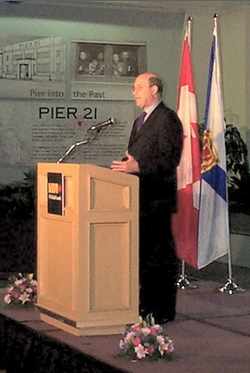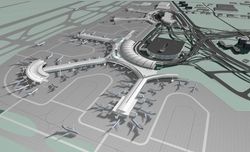Fri, Mar 21, 2003
Canada's Transport Minister, David Collenette, has introduced
the Canada Airports Act in the House of Commons. The bill
modernizes the corporate governance regime for airport authorities
and establishes a framework for disclosure and accountability for
Canada's major airports.
 "Introducing this legislation is an important step
in addressing new and emerging issues that have arisen since the
National Airports Policy was put in place in 1994, as well as in
protecting the interests of Canadians, the airports and the airline
industry," said Mr. Collenette (right). "With the successful
divestiture of Canada's major airports completed, it is in the best
interests of all parties to have one common, yet flexible,
governance structure and a strengthened accountability framework to
guide the operators of Canada's major airports."
"Introducing this legislation is an important step
in addressing new and emerging issues that have arisen since the
National Airports Policy was put in place in 1994, as well as in
protecting the interests of Canadians, the airports and the airline
industry," said Mr. Collenette (right). "With the successful
divestiture of Canada's major airports completed, it is in the best
interests of all parties to have one common, yet flexible,
governance structure and a strengthened accountability framework to
guide the operators of Canada's major airports."
The legislation contains a new airports policy statement to
replace the National Airports Policy, which was the basis for the
commercialization of the airports identified as being part of
Canada's National Airports System. It completes the legislative
framework for Canada's transportation infrastructure, providing a
framework for airports in keeping with other legislative
initiatives such as for Canada's air navigation and ports
systems.
The proposed Act sets out the roles and obligations of the
Government of Canada and of the affected airport operators. The Act
will affect 30 airports when it comes into force. It will also
apply to any additional airports that, in the future, reach a
passenger threshold of more than 200,000 passengers per year
averaged over three years.
 "Canada's airport divestiture initiative is one of
the most successful commercialization undertakings in the world.
Airport authorities have expanded rapidly, providing an improved
level of service to the travelling public and generating
significant economic activity in many regions," said Mr.
Collenette. "This new legislation will build on that success."
"Canada's airport divestiture initiative is one of
the most successful commercialization undertakings in the world.
Airport authorities have expanded rapidly, providing an improved
level of service to the travelling public and generating
significant economic activity in many regions," said Mr.
Collenette. "This new legislation will build on that success."
The introduction of the Canada Airports Act is the culmination
of extensive studies and stakeholder consultations and responds to
recommendations in a number of recent reviews. It also fulfils one
of the commitments made in Straight Ahead - A Vision for
Transportation in Canada and contributes to the Government of
Canada's governance agenda as set out in the 2002 Speech from the
Throne.
More News
Terminal Radar Service Area Airspace surrounding designated airports wherein ATC provides radar vectoring, sequencing, and separation on a full-time basis for all IFR and participa>[...]
Very High Frequency (VHF) The frequency band between 30 and 300 MHz. Portions of this band, 108 to 118 MHz, are used for certain NAVAIDs; 118 to 136 MHz are used for civil air/grou>[...]
“From approximately November 2021 through January 2022, Britton-Harr, acting on behalf of AeroVanti, entered into lease-purchase agreements for five Piaggio-manufactured airc>[...]
Also: Virtual FLRAA Prototype, IFR-Capable Autonomous A/C, NS-32 Crew, Golden Dome Missile Defense Bombardier announced that the first production Global 8000 successfully completed>[...]
Aero Linx: The 1-26 Association (Schweizer) The Association’s goal is to foster the helpfulness, the camaraderie, and the opportunity for head-to-head competition that is fou>[...]
 ANN's Daily Aero-Term (05.29.25): Terminal Radar Service Area
ANN's Daily Aero-Term (05.29.25): Terminal Radar Service Area ANN's Daily Aero-Term (05.30.25): Very High Frequency (VHF)
ANN's Daily Aero-Term (05.30.25): Very High Frequency (VHF) Aero-News: Quote of the Day (05.30.25)
Aero-News: Quote of the Day (05.30.25) Airborne 05.23.25: Global 8000, Qatar B747 Accepted, Aviation Merit Badge
Airborne 05.23.25: Global 8000, Qatar B747 Accepted, Aviation Merit Badge ANN's Daily Aero-Linx (05.30.25)
ANN's Daily Aero-Linx (05.30.25)




